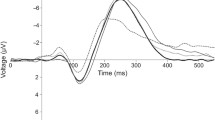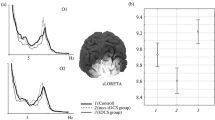Components of event-related potentials (ERP) were studied using an active sound signal discrimination task in northern schoolchildren aged 12–18 years with impaired mental development and learning difficulties (IQ 65 ± 4) and without mental developmental impairments (IQ 90 ± 10). The peak latency of the P300 component in the central and parietal areas of the cortex on perception and discrimination of target sound stimuli was greater in northern children with impaired mental development (Cz 370 ± 36 msec, 8.8 ± 4.1 μV; Pz 375 ± 39 msec, 10.2 ± 3.3 μV) as compared with their normally developing peers (339 ± 28 msec, 10.4 ± 3.0 μV; 340 ± 35 msec, 12.2 ± 2.2 μV, respectively). Negative correlations were found between cognitive abilities, the accuracy and speed of information processing in an attention task, and the latency of the P300 component, with positive correlations with the amplitude of the P3 component for measures of attention. The spatial, temporal, and amplitude characteristics of ERP in adolescents with impaired mental development reflect the functional incompetence or immaturity of the hierarchical organization of the system processing and discriminating information arriving in the brain and requiring concentration of attention and decision-taking.
Similar content being viewed by others

References
E. D. Aleshina, N. N. Koberskaya, and I. V. Damulin, “Cognitive P300 event-related potentials: methodology, experience of use, and clinical significance,” Zh. Nevrol. Psikhiat., 8, 77–84 (2009).
A. D. Andreeva and A. M. Prikhozhan, “A method for the diagnosis of learning motivation and emotional attitude to learning in intermediate and higher school classes,” Psikhol. Diagnostika, 1, 33–38 (2006).
V. P. Rozhkov, E. G. Sergeeva, and S. I. Soroko, “Age-related dynamics of event-related potentials in the brain in involuntary and voluntary attention to deviant stimuli in northern schoolchildren,” Ros. Fiziol. Zh., 94, No. 11, 1240–1258 (2008).
E. M. Rutman, Event-Related Potentials in Psychology and Psychophysiology, Nauka, Moscow (1979).
S. I. Soroko, V. P. Rozhkov, and S. S. Bekshaev, “Characteristics of seasonal rearrangements in the central regulatory mechanisms in northern children with different levels of social risk,” Ros. Fiziol. Zh., 99, No. 12, 1435–1449 (2013).
Structural-Functional Organization of the Developing Brain, Nauka, St. Petersburg, Leningrad (1990).
C. Shagass, Evoked Brain Potentials in psychiatry [Russian translation], Mir, Moscow (1975).
L. A. Yasyukova, Optimization of Learning and Development in Children with Minimal Mental Dysfunction. The Toulouse-Piéron Test: Methodological Guidelines, IMATON, St. Petersburg (2007).
H. U. Amin, A. S. Malik, N. Kamel, et al., “P3 correlates with learning and memory abilities and fluid intelligence,” J. Neuroeng. Rehabil., 12, 87 (2015), doi: https://doi.org/10.1186/s12984-015-0077-6.
R. Bandhu, N. Shankar, O. P. Tandon, and N. Madan, “Effects of iron therapy on cognition in anemic school going boys,” Ind. J. Physiol. Pharmacol., 47, No. 3, 301–310 (2003).
O. Boucher, C. H. Bastien, G. Muckle, et al., “Behavioural correlates of the P3b event-related potential in school-age children,” Int. J. Psychophysiol., 76, No. 3, 148–157 (2010).
E. R. Braverman and K. Blum, “P3 (latency) event-related potential: an accurate predictor of memory impairment,” Clin. Electroencephalogr., 34, No. 3, 124–139 (2003).
Y. J. Chen and C. C. Hsu, “Effects of prenatal exposure to PCBs on the neurological function of children: a neuropsychological and neurophysiological study,” Dev. Med. Child Neurol., 36, No. 4, 312–320 (1994).
E. V. Courchesne, “Neurophysiological correlates of cognitive development: Changes in long latency event-related potentials from childhood to adulthood,” Electroencephalogr. Clin. Neurophysiol. Clin. Neurophysiol., 45, No. 4, 468–482 (1978).
V. De Pascalis, V. Varriale, and A. Matteoli, “Intelligence and P3 components of the event-related potential elicited during an auditory discrimination task with masking,” Intelligence, 36, No. 1, 35–47 (2008).
M. V. Della Coletta, R. H. Scola, G. R. Wiemes, et al., “Event-related potentials (P3)and neuropsychological assessment in boys exhibiting Duchenne muscular dystrophy,” Arq. Neuropsiquiatr., 65, No. 1, 59–62 (2007).
O. Duman, S. Arayici, C. Fettahoglu, et al., “Neurocognitive function in patients with β-thalassemia major,” Pediatr. Int., 53, No. 4, 519–523 (2011).
C. C. Duncan, R. J. Barry, J. F. Connolly, et al., “Event-related potentials in clinical research: guidelines for eliciting, recording, and quantifying mismatch negativity, P300, and N400,” Clin. Neurophysiol., 120, No. 11, 1883–1908 (2009).
R. J. Gurrera, D. F. Salisbury, B. F. O’Donnell, et al., “Auditory P3 indexes personality traits and cognitive function in healthy men and women,” Psychiatry Res., 133, No. 2–3, 215–228 (2005).
J. C. Hansen and S. A. Halyard, “Temporal dynamics of human auditory selective attention,” Psychophysiology, 25, 316–329 (1988).
D. Hedges, R. Janis, S. Mickelson, et al., “P300 amplitude in Alzheimer’s disease: a meta-analysis and meta-regression,” Clin. EEG Neurosci., 47, No. 1, 48–55 (2016).
W. J. Huang, W. W. Chen, and X. Zhang, “The neurophysiology of P300 – an integrated review,” Eur. Rev. Med. Pharmacol. Sci., 19, No. 8, 1480–1488 (2015).
T. B. Kamel, M. T. Abd Elmonaem, L. H. Khalil, et al., “Children with chronic lung diseases have cognitive dysfunction as assessed by event-related potential (auditory P3)and Stanford-Binet IQ (SB-IV) test,” Eur. Arch. Otorhinolaryngol. (2016), doi: https://doi.org/10.1007/s00405-016-4044-z.
A. Kazis, V. Kimiskidis, G. Georgiadis, and K. Kapinas, “Cognitive event-related potentials and magnetic resonance imaging in myotonic dystrophy,” Neurophysiol. Clin., 26, No. 2, 75–84 (1996).
J. Kropotov, V. Ponomarev, E. P. Tereshchenko, et al., “Effect of aging on ERP components of cognitive control,” Front. Aging Neurosci., 8, 69 (2016), doi: https://doi.org/10.3389/fnagi.2016.00069.
F. Martin, E. Delpont, G. Suisse, et al., “Long latency event-related po tentials (P3)in gifted children,” Brain Dev., 15, No. 3, 173–177 (1993).
J. Muiioz-Ruata, G. Gomez-Jarabo, M. Martin-Loeches, and L. Martinez-Lebrusant, “Neurophysiological and neuropsychological differences related to performance and verbal abilities in subjects with mild intellectual disability,” J. Intellect. Disabil. Res., 44, No. 5, 567–578 (2000).
Y. Naganuma, T. Konishi, M. Matsui, et al., “The relationship between P3 latencies, and WISC-R and Wechsler memory scale results in epileptic children,” No. To. Hattatsu., 25, No. 6, 515–520 (1993).
R. D. Oades, “Frontal, temporal and lateralized brain function in children with attention-deficit hyperactivity disorder: a psychophysiological and neuropsychological viewpoint on development,” Behav. Brain Res., 94, 83–95 (1998).
R. D. Oades, A. Dittmann-Balcar, R. Schepker, et al., “Auditory event related potentials (ERPs)and mismatch negativity (MMN)in healthy children and those with attention-deficit or Tourette/tic symptoms,” Biol. Psychol., 43, 163–185 (1996).
J. M. Olichney, J. C. Yang, J. Taylor, and M. Kutas, “Cognitive event-related potentials: biomarkers of synaptic dysfunction across the stages of Alzheimer’s disease,” J. Alzheimers Dis., 26, Supplement 3, 215–228 (2011).
R. V. Pedroso, F. J. Fraga, D. I. Corazza, et al., “P3 latency and amplitude in Alzheimer’s disease: a systematic review,” Braz. J. Otorhinolaryngol., 78, No. 4, 126–132 (2012).
T. W. Picton and M. J. Taylor, “Electrophysiological evaluation of human brain development,” Dev. Neuropsychology, 31, No. 3, 249–278 (2007).
J. Polich, “Neuropsychology of P3,” in: The Oxford Handbook of Event-Related Potential Components, S. J. Luck and E. S. Kappenman (eds.), Oxford Univ. Press, Oxford (2012), Vol. 2, pp. 159–188.
J. Polich, “Updating P3: an integrative theory of P3a and P3b,” Clin. Neurophysiol., 118, No. 10, 2128–2148 (2007).
R. Portin, T. Kovala, P. Polo-Kantola, et al., “Does P3 reflect attentional or memory performances, or cognition more generally?” Scand. J. Psychol., 41, No. 1, 31–40 (2000).
M. Senderecka, A. Grabowska, K. Gerc, et al., “Event-related potentials in children with attention deficit hyperactivity disorder: an investigation using an auditory oddball task,” Int. J. Psychophysiol., 85, No. 1, 106–115 (2012).
R. van Dinteren, M. Arns, M. L. A. Jongsma, and R. P. C. Kessels, “P3 development across the lifespan: a systematic review and meta-analysis,” PLoS One, 9, No. 2, e87347 (2014).
N. Vaney, F. Khaliq, and Y. Anjana, “Event-related potentials study in children with borderline intellectual functioning,” Ind. J. Psychol. Med., 37, No. 1, 53–57 (2015).
R. Verleger, “On the utility of P3 latency as an index of mental chronometry,” Psychophysiology, 34, No. 2, 31–256 (1997).
F. Zenker and J. J. Barajas, “Auditory P3 development from an active, passive and single-tone paradigms,” Int. J. Psychophysiol., 33, No. 2, 99–111 (1999).
Author information
Authors and Affiliations
Corresponding author
Additional information
Translated from Rossiiskii Fiziologicheskii Zhurnal imeni I. M. Sechenova, Vol. 103, No. 1, pp. 107–120, January, 2017.
Rights and permissions
About this article
Cite this article
Shemyakina, N.V., Nagornova, Z.V., Belisheva, N.K. et al. Assessment of the Parameters of Cognitive Potentials in Adolescent Northerners in Health and Developmental Delays. Neurosci Behav Physi 48, 534–542 (2018). https://doi.org/10.1007/s11055-018-0596-2
Received:
Published:
Issue Date:
DOI: https://doi.org/10.1007/s11055-018-0596-2



